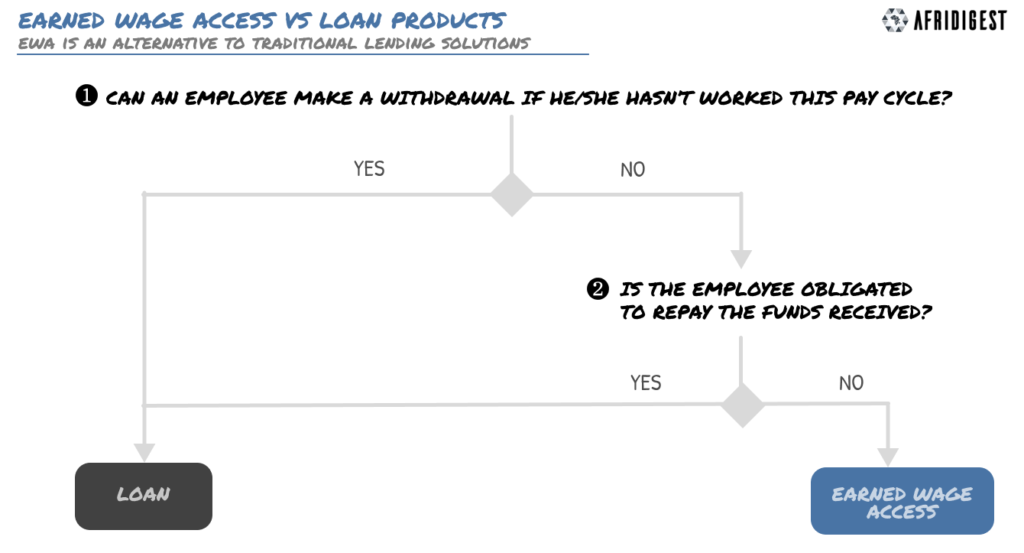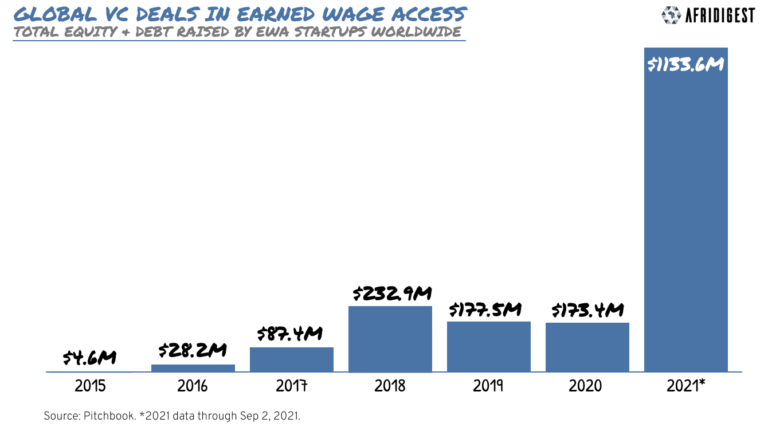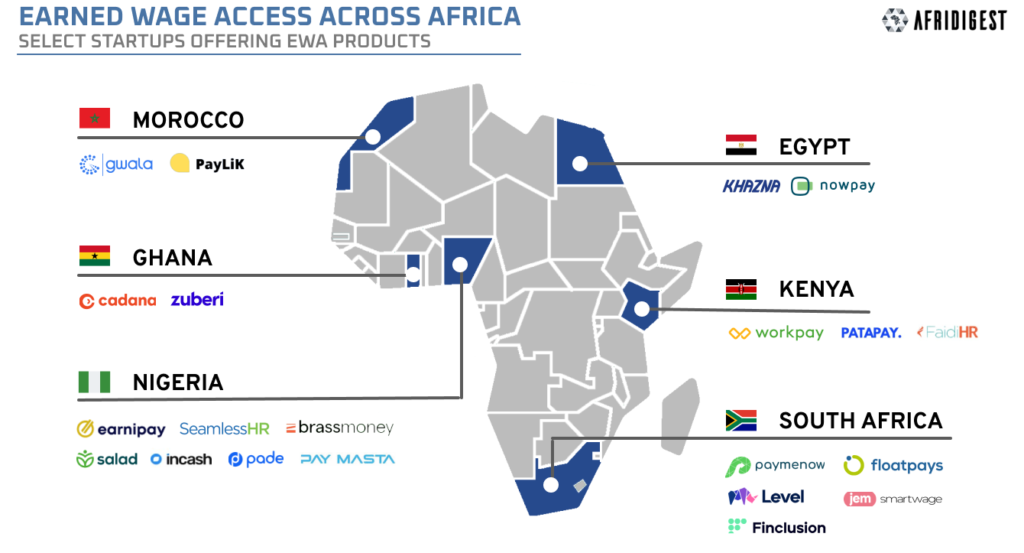In the not-so-distant future, ‘streaming salary’ might become the norm; wages might be wired continuously, in real time, to workers’ wallets worldwide as they’re earned.
But that future doesn’t yet exist.
Today, employees are generally compensated on fixed payroll cycles. In North America, for example, salary is typically paid bi-weekly or semi-monthly for the average employee. And across the rest of the world, one paycheck per month is largely the norm.

But while salary is paid on a fixed cycle in arrears, consumption & commerce happen daily. And because many workers lack significant savings, the time between pay cycles is often marked by cash flow challenges, a lack of liquidity, and financial stress.
That’s one reason the global payday lending market is large and growing. Workers who need help between paychecks turn to payday loans and similar solutions, but these usually come at a steep cost — excessive interest rates, high fees, and a strong potential of entering into debt traps.
Enter earned wage access.
Over the last decade, a slew of startups has begun seizing the opportunity to redistribute value from payday lending incumbents back to employees. Often called ‘on-demand pay,’ ‘salary on demand,’ or ‘earned wage access’ (EWA), this growing category of alternative finance helps address liquidity gaps employees face between paychecks.
While EWA providers employ a variety of commercial models, EWA products generally work in a similar way: the EWA provider integrates with data sources (e.g., the employer’s payroll system) to calculate accrued wages and make an appropriate amount available, the employee requests withdrawals from the EWA provider, approved funds are disbursed in near real time before payday, and the employee receives the balance of his/her regular salary minus the amount withdrawn and any applicable fees on the regular pay cycle.

Unlike payday lending and similar financing solutions, there are no payback obligations with EWA. EWA platforms simply give employees access to their earned and accrued, but unpaid wages. Consequently, because EWA isn’t a loan, there’s no payback, no interest, no late fees, no credit reporting, and no risk of entering debt traps; in fact, EWA reduces employee reliance on predatory debt.

While direct-to-consumer EWA models are increasingly common in some markets, EWA platforms typically employ a B2B2C model where they partner with employers to reach employees.
Critically for employer adoption, payroll remains on the regular cash flow cycle. Employers can enable EWA with no disruption to working capital and only minor changes to payroll administration. And in most cases, they can also set additional guidelines and restrictions, such as which employees can access EWA, how much they can access, and how frequently.
While it’s clear that EWA addresses a real pain point for employees worldwide, employers are increasingly recognizing EWA’s positive impact on business results. On the one hand, it’s a differentiated benefit that bolsters employee recruiting and retention, and on the other, it’s a financial wellness tool that amplifies employee productivity & engagement by reducing financial stress.

A Wendy’s franchise in Canada advertises earned wage access solutions to attract workers. Source: Tate Hackert.
EWA platforms generally position themselves in the marketplace as a socially responsible, financial wellness alternative to payday lenders. And because they generally seek to take market share away from incumbent payday lending providers, many use the global payday loan market as a proxy for the scale of the EWA opportunity — it’s estimated at over $30 billion today and is projected to reach ~$50 billion by 2030.
Earned wage access platforms are proliferating across developed & emerging markets.
EWA first came to market in the 2010s in the US with platforms like Flexwage, PayActiv, and Earnin pioneering the concept. And today, even juggernauts like Block (formerly Square) offer EWA solutions.
While the US still leads the way according to the Everest Group & other research firms, earned wage access solutions are increasingly a worldwide phenomenon, one that’s accelerated in recent years.

For example, startups offering earned wage access products raised more capital in 2021 than they did cumulatively from 2015 to 2020.

While all workers paid on a fixed payroll schedule can benefit from EWA solutions, EWA is more valuable where workers have lower levels of savings and thus largely rely on earnings to meet expenses.
In developed markets, this typically means a primary or initial target market of blue-collar workers and entry-level or lower-skilled white-collar employees. But across emerging markets where large segments of the population remain financially underserved, EWA is applicable and appealing to a much broader set of the population from day one.
It’s perhaps not surprising then that EWA platforms are seeing tremendous momentum across emerging markets today.

Earned wage access may be a natural fit for African markets.
Across Africa, access to formal credit is limited. That’s one reason why the continent has some of the highest levels of borrowing from family or friends according to the World Bank. Moreover, levels of insurance penetration across Africa are half the world average according to McKinsey, and insurance penetration has a negative correlation with EWA usage. These and other tailwinds such as low private savings rates bode well for EWA across Africa.
Consequently, a number of innovators are seizing the opportunity to pioneer EWA models across the African continent.

These include:
- Khazna, an Egyptian financial super app
- Nowpay, an Egyptian financial wellness platform
- Cadana, a Ghanaian payroll platform
- Zuberi, a Ghanaian employee benefits platform
- Workpay, a Kenyan payroll platform
- Earnipay, a Nigerian EWA platform
- SeamlessHR, a Nigerian HR & payroll platform
- BrassMoney, a Nigerian money management platform for professionals
- Salad, a Nigerian EWA platform
- PayMeNow, a South African EWA platform
- FloatPays, a South African employee wellness platform
- Jem (formerly Smartwage), a South African HR & payroll platform
The future of earned wage access.
Several questions surround pure-play EWA platforms across Africa (and the world), however.
Is it a standalone business or an add-on product? Is it inherently a commodity or is there possible differentiation? Are EWA products natural partners or eventual competitors to HR SaaS offerings? How do you win?
While the majority of these questions are beyond the scope of this introductory article, what’s clear is that, 1) EWA platforms offer a great way to access unique employee data, and 2) generally speaking, EWA tech on its own is easily replicable.
One of the main ‘technical’ challenges lies in integrating with a wide variety of payroll systems — a challenge that is likely to be easily overcome. Beyond that, access to a significant lending capacity/balance sheet can help gain initial momentum, but ultimately winning in the near term is likely to be a function of a differentiated distribution/GTM strategy.
That said, the pure-play EWA platforms of today will likely follow one of two paths over the medium/long term: becoming a full-service HR benefits & employee wellness platform (i.e. offering some mix of HR/payroll/benefits management software, personal finance education/management, and other employee-focused offerings) or becoming a full-service credit & financial services provider to both employees and employers.
Across Africa in particular, the transition of Egypt’s Khazna from an EWA provider to a financial super app, the rebranding & refocusing of South African EWA platform Smartwage to the HR platform Jem, and the launch of earned wage access offerings by Nigerian payroll platform SeamessHR are likely to be particularly instructive to current and future market participants.
Interested in going deeper? Our research & advisory unit Afridigest Intelligence supports startups, corporates, and investors with strategic intelligence. Get in touch: intelligence@afridigest.com





Share: